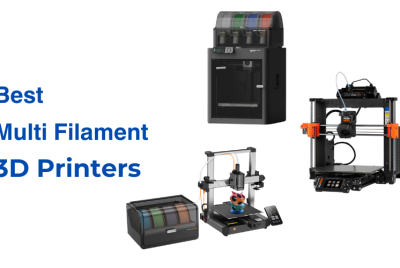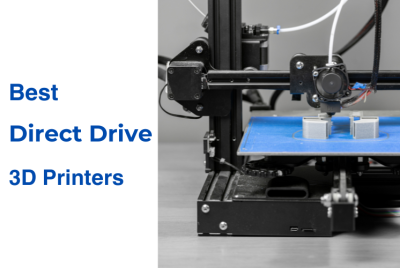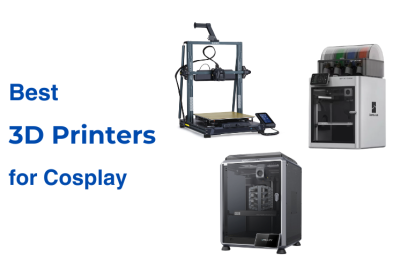Bambu Lab X1E Full Review
The Bambu Lab X1E, the predecessor to the X1-Carbon launched in October of 2023. This 3D printer is made for 3D printing professionals— industrial designers, architects, or small business owners. Building on the success of the X1-Carbon, Bambu Lab has introduced the X1E with enhancements specifically requested by its professional customer base. These upgrades include an improved air filtration system, heightened network security, an actively heated chamber capable of reaching 60ºC for optimal results with engineering-grade materials, and a nozzle that heats up to 320ºC. The X1E is designed for ease of use right out of the box with its straightforward setup. AMS is included in the package, which is very useful for professional-grade printing. In this Bambu Lab X1E full review, we will take a look at the improvements made from its X1-Carbon sibling, the features, comparisons, and its real-world applications.
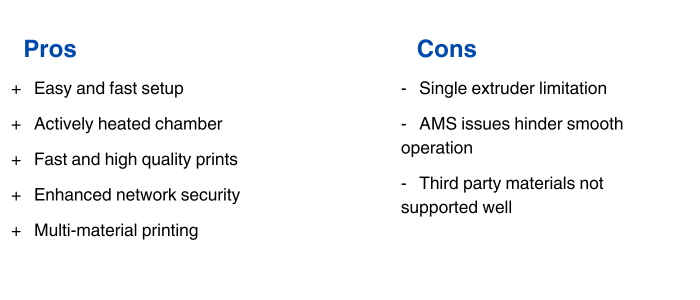
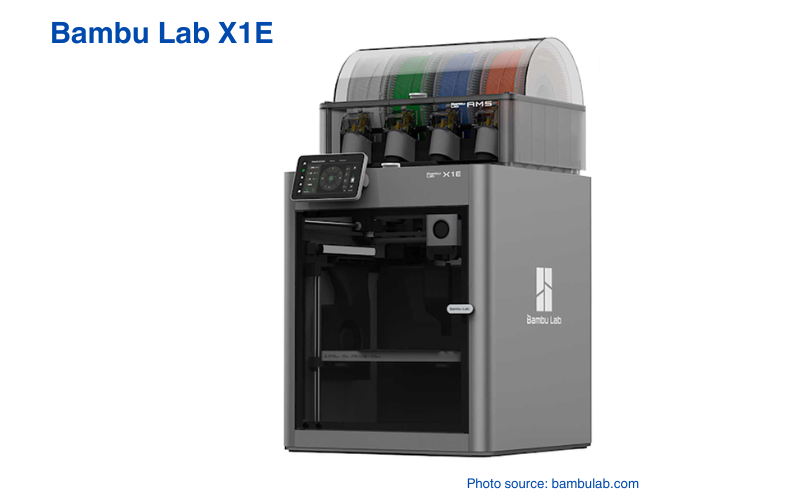
Design and Build Quality
Professional-Looking Sturdy Construction
The Bambu Lab X1E features a clean, minimalist design crafted from high-quality aluminum. It has a sturdy metal frame that speaks to its industrial purpose. The enclosure is constructed from durable, high-grade materials designed to withstand the higher temperatures required for printing with engineering-grade filaments. The actively heated chamber can reach up to 60ºC. This enhancement is crucial for achieving better results with materials that tend to warp or shrink if not kept at a consistent temperature. The heated chamber ensures that the internal environment remains stable, reducing the chances of failed prints, especially for carbon fiber 3D printing, or other advanced materials. The X1E also comes equipped with a heavy-duty air filtration system that is designed to capture and filter out particles and fumes that are often released when printing with certain materials.
Ease of Assembly
Setting up the Bambu Lab X1E is straightforward. The process involves scanning QR codes that bring up step-by-step instructions on your smartphone, guiding you through tasks like removing protective screws and plugging in the filament lines. The user-friendly design extends to the assembly phase, where clear visuals and simple directions ensure you won’t be left guessing at any point. Within approximately 45 minutes, the X1E can go from unboxing to being fully operational, ready to start producing high-quality prints.
Key Features and Specifications
| Key Features | Specifications |
|---|---|
| Actively Heated Chamber | Build Volume: 256 x 256 x 256 mm |
| Heavy-Duty Air Filtration System | Print Speed: Up to 500 mm/s |
| 5-Inch Color Touchscreen | Layer Height: 0.05-0.30 mm |
| Built-In Camera for Monitoring | Nozzle Diameter (Optional): 0.2 mm, 0.6 mm, 0.8 mm |
| Automatic Filament Detection | Max Nozzle Temperature: 320°C |
| Power Loss Recovery | Filament Compatibility: PLA, PETG, TPU, PVA, BVOH: Optimal ABS, ASA, PC, PA, PET: Superior Carbon/Glass Fiber Reinforced PLA, PETG, PA, PET, PC, ABS, ASA: Superior PPA-CF/GF, PPS, PPS-CF/GF: Ideal |
| Dual-Gear Direct Extruder | Supported Filament Diameter: 1.75 mm |
| Metal Frame and Enclosure | Connectivity: SD Card, USB |
| Frame Material: Aluminum |
The Bambu Lab X1E is engineered for high performance, featuring an actively heated chamber that can reach up to 60ºC, enhancing print quality with materials that are prone to warping. The 320ºC nozzle allows for the use of a wide variety of high-temperature filaments, making it suitable for engineering applications. The air filtration system combines a G3 pre-filter, an H12 HEPA filter, and activated carbon, which effectively reduces particulate matter and VOCs, ensuring a safer working environment. Additionally, the printer’s CoreXY motion structure provides stability and speed, achieving up to 500 mm/s in print speed with 20,000 mm/s² acceleration. The X1E is also equipped with AI features that include failure detection and vibration compensation, ensuring consistent print quality even at high speeds.
Comparisons
Bambu Lab X1E vs Bambu Lab X1-Carbon

Here’s how the Bambu Lab X1E stacks up against the X1-Carbon, another high-performance model in the Bambu Lab lineup. While both printers share a similar foundation, they cater to different needs depending on the user’s requirements:
Build Chamber: The X1E features an actively heated chamber that can reach up to 60ºC. The X1-Carbon lacks this actively heated chamber, making it less ideal for certain engineering-grade materials.
Network Security: The X1E is equipped with enhanced network security, including an Ethernet connection and WPA2-Enterprise Wi-Fi Authentication. The X1-Carbon has standard Wi-Fi connectivity without these additional security features.
Price: The X1-Carbon is a more budget-friendly option within the high-end 3D printer market. However, the X1E justifies its higher price with additional professional-grade features and capabilities for industrial use.
Bambu Lab X1E vs UltiMaker S5

When comparing the Bambu Lab X1E to the UltiMaker S5, several key differences highlight the strengths and intended users for each machine:
Temperature Control: While both printers are designed to handle advanced materials, the X1E features an actively heated chamber that can reach up to 60ºC. The UltiMaker S5 does not have an actively heated chamber, which may limit its performance with some high-temperature materials.
Automation and Monitoring: The Bambu Lab X1E comes with AI-powered failure detection and a built-in camera for real-time monitoring. The UltiMaker S5 also has monitoring features, including a built-in camera and material station for automatic material handling. But it relies more on user intervention for error detection and correction.
Price: The UltiMaker S5 is significantly more expensive than the Bambu Lab X1E, retailing at nearly four times the price. The S5’s higher price reflects its larger build volume and established brand reputation. But for many users, the X1E has comparable functionality at a fraction of the cost.
Real-World Applications
The Bambu Lab X1E is designed to meet the needs of professionals across a range of industries. It has advanced features that make it suitable for various real-world applications:
Engineering and Prototyping
The X1E excels in producing prototypes and functional parts with engineering-grade materials like ABS, PC, and carbon fiber-reinforced filaments. Its actively heated chamber reduces warping and improves interlayer bonding. This aspect is crucial when creating parts that require high precision and strength.
Architecture and Design
For architects and designers, the X1E has the ability to print detailed scale models with materials that maintain dimensional stability. The machine’s high-temperature nozzle and precise layer control enable it to accurately render intricate designs and handle complex geometries.The integrated air filtration system also makes it feasible to operate the X1E in an office environment. Makers need not worry about fumes or particulate matter, which is often a concern in design studios.
Industrial Design and Manufacturing
For industrial designers and small-scale manufacturers, the X1E offers the capability to produce high-quality parts quickly and efficiently. The printer’s AI-powered failure detection and real-time monitoring reduce the risk of errors during long print jobs. This makes it a dependable choice for producing short-run manufacturing parts, jigs, and fixtures. Its dual-gear direct extruder provides consistent filament feeding.
Conclusion
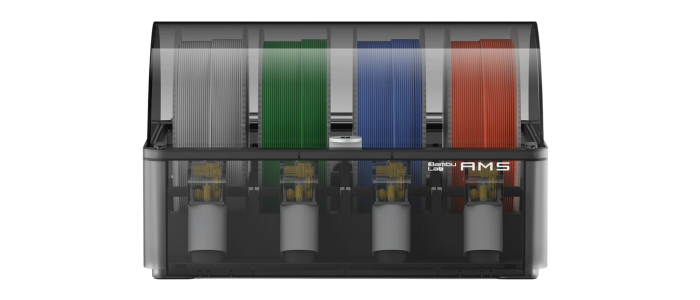
The Bambu Lab X1E has a combination of advanced features and sturdy build quality. Its actively heated chamber, high-temperature nozzle, and AI-driven monitoring equip it to handle demanding materials and complex projects. The X1E delivers performance that meets the high standards required in professional settings. Moreover, its enhanced network security and real-time monitoring features make it an attractive option for corporate environments where data integrity and machine uptime are critical. Despite its advanced capabilities, the X1E remains accessible to users with various levels of experience in 3D printing.


